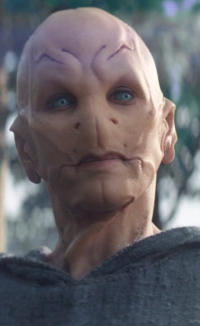Kelpien
| SPECIES | |||
|---|---|---|---|
| Kelpien | |||
 | |||
| Homeworld: | Kaminar | ||
| Quadrant: | Alpha | ||
| Affiliation: | Unknown | ||
| Biology | |||
| Average Male Height: | 6'4" | ||
| Average Male Weight: | 150 | ||
| Average Female Height: | |||
| Average Female Weight: | |||
| Minimum Academy Age: | 21 | ||
| Life Expectancy: | 300 | ||
| Distinctive Features: | |||
| Playability | |||
| PRC Rated: | Yes | ||
| NPC Rated: | Yes | ||
 | |||
Kelpiens are a humanoid species from Kaminar. Empathy is a defining trait hardwired in the Kelpien DNA.
They are one of two sentient species on the planet, along with the Ba'ul, with whom they have a historically-known complicated relationship.
Physiology
Kelpiens are often described as tall and with a "lanky build." They have brown-orange skin, no hair on their heads or visible elsewhere, though males have been documented to grow facial hair at during their advanced ages. Tendril-like threat ganglia are known to splay out from the back of their heads when danger is sensed. Female Kelpiens typically have smoother skin than males.
Compared to Humans, Kelpiens have better visual, auditory, and tactile receptors. This species has a larger optical window compared to other humanoids, and are able to see far deeper into the light spectrum than them, including ultraviolet and heat signatures. This gives Kelpiens the ability to sense predators from as much as ten kilometers. On Kaminar, Kelpiens were considered the "prey" to the binary symbiosis between them and the Ba'ul, who considered themselves the "predator." Over time, this led to the Kelpiens developing their heightened senses, as well as superior strength and stamina when compared to other humanoids.
Vahar'ai
During any point in their lives, Kelpiens can choose to undergo a physiological process called the vahar'ai, a biological event that is unique to the Kelpien species
- A painful process, it results in the loss of the threat ganglia, and the apparent suppression of fear responses. Kelpiens that go through this change reach what is considered an "evolved" state.
The process has been considered a crucial factor in the history of Kelpien-Ba'ul relations. Both species interpret this change as a terminal condition, signaling that a Kelpien was ready to be culled for slaughter by their "superiors," the Ba'ul. - Kelpiens undergoing the vahar'ai are expected to present themselves for culling, which is said to make the pain go away. The alternative is believed to be madness. In reality, vahar'ai is a temporary condition, which ends with the ganglia detaching, after which vital signs return to normal. After undergoing vahar'ai, a Kelpien's excessive fear responses appear to be suppressed.
- During this process, new keratin-based structures in the cartilage previously housing the threat ganglia are formed. These new organs allow for the forcibly expelling of spines that grow from them.
These new structures extend outward in the same manner as the old threat ganglia in moments of great stress. - Early symptoms resemble those of a typical cold in humanoids. In Kelpiens, these symptoms develop into increased heart rate, spiking adrenal levels, increased neural activity, and high levels of pain.
A signature symptom is the inflammation of the threat ganglia.
Pregnancy
Female Kelpiens develop red spots on their foreheads when they become pregnant. To an uninformed eye, these spots can be mistaken for radiation burns.
History
In the distant past, Kelpiens were vicious and warlike, and greatly outnumbered the Ba'ul.
Documented as late as 2257, Kelpiens as a whole were at a pre-warp technological level, most likely due to the Ba'ul. Several hundred years before the 23rd century, Kelpiens who had undergone vahar'ai fought against the Ba'ul, leading to almost extinction of the Ba'ul. Using more advanced technology, the Ba'ul then subjugated the Kelpiens, integrating a technologically supported ideology into Kelpien society. Known to the Kelpiens as the "Great Balance," this ideology kept the Kelpiens subservient by teaching them that they were a prey species for the Ba'ul. Kelpiens were monitored by pylons installed by the Ba'ul, which they called the "Watchful Eye."
The first Kelpien known to have achieved contact with greater galactic society was a 23rd century Kelpien who salvaged an abandoned Ba'ul communications array, using it to make contact with Starfleet. This individual Kelpien was granted refugee status, based on the understanding that the remainder of his species would remain subject to the Prime Directive.
When the truth about vahar'ai was threatened to be revealed, the Ba'ul made a last, "hail Mary" type effort to commit genocide against the Kelpiens, in order to keep them subservient.
Over 60% of the Kelpien population underwent vahar'ai, breaking the concept of the "Great Balance."
In early 2258, Kelpiens were able to assist with the "Battle near Xahea" by piloting Ba'ul fighters.
Culture & Society
Until they became warp-capable, the Kelpien way of life had always been oriented toward death, and their role as prey to the Ba'ul. Hunted, bred, and farmed, this sentient humanoid species were treated by the Ba'ul as livestock once was on Earth.
Led to believing their role as a prey species to be part of the "Great Balance of Kaminar", Kelpiens were expected to offer their lives to sustain the Ba'ul after reaching vahar'ai. These harvests (referred to as "cullings") consisted of Kelpiens kneeling in a circle of stones beneath the Ba'ul ship, awaiting a bright light, and their ultimate disappearance. Kelpien priests explained how this sacrifice tied into the "Great Balance," as well as an entity called the "Watchful Eye," which was said to be in the sky.
Kelpiens live in packs, and mostly occupy hut-like houses, which include elements that emitted a yellow-orange light. Fire was used for both light and food, constantly in use throughout the day and by night. They harvest flowers and a type of kelp-like aquatic plant, the latter with nets which were stitched using needles. Their spoken and written languages were different than that of the Ba'ul.